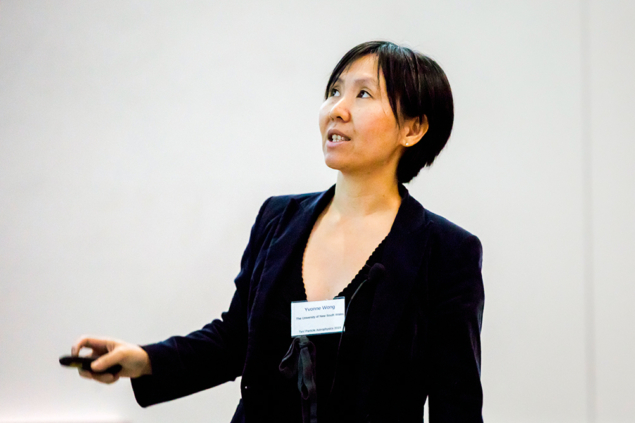
Despite the thick haze of bushfire smoke hanging over the skyline, 200 delegates gathered in Sydney from 2 to 6 December for the 14th edition of the TeV Particle-Astrophysics conference (TeVPA), to discuss the status and future of astroparticle physics.
The week began with a varied series of talks on dark matter. Luca Grandi (Chicago) and Tom Thorpe (LNGS) updated delegates on progress towards the next generation of xenon and argon-based experiments: these massive underground detectors are now approaching total masses in the multiton-scale. Experiments like XENON, LZ and DarkSide are poised to be so sensitive to rare signals that they will even able to detect coherent elastic neutrino-nucleus scattering – the ultimate background to direct dark-matter searches. Meanwhile, Greg Lane (Australian National University) brought us news of exciting developments in Australian dark-matter research. The Stawell Underground Laboratory—the first deep underground site in the southern hemisphere—will host part of the SABRE experiment, which aims to test the annually modulating event rate seen by the DAMA experiment. This highly controversial, dark-matter-like signal has been observed for two decades by DAMA, but remains in irreconcilable tension with null results from many other experiments. Excavation at Stawell is underway as of October last year. The site will form a central component of the Centre of Excellence for Dark Matter Particle Physics, recently awarded by the Australian Research Council.
Galaxies can be used as laboratories for particle physics
Eminent astrophysicist Joe Silk (IAP) reviewed the many ways in which galaxies can be used as laboratories for particle physics. One of the most persistent hints of dark-matter particle interactions in astrophysical data is the notorious excess of GeV gamma rays coming from the galactic centre. Recent analyses of the excess using improved statistical techniques and better models for the Milky Way’s central bulge were detailed by Shunsaku Horiuchi (Virginia Tech). While dark-matter-related explanations remain tempting, there is growing evidence in support of millisecond pulsars being responsible, given the spatial morphology of the excess. Francesca Calore (LAPTh) told us that multi-wavelength probes of the excess will be possible in the near-future, and may finally allow us to conclusively determine the origin of the signal.
Probing the cosmos
Delegates enjoyed a stirring series of talks on the ever-increasing number of probes of cosmology. Following a review of the post-Planck status of cosmology by Jan Hamaan (UNSW), Xuelei Chen (CAS) explained how the unique 21 cm radio line can be used to map neutral hydrogen throughout the universe and across cosmic time. A host of upcoming ground and space-based experiments attempting to observe the sky-averaged 21 cm line will hopefully allow us to peer back to the birth of the first stars at “cosmic dawn”. We also heard from Yvonne Wong (UNSW) about how cosmological data can be used as a test of neutrino physics and how neutrino physics may in turn be a means to alleviate tensions between cosmological datasets. For example, strong self-interactions between neutrinos could bring the two increasingly divergent measurements of the Hubble constant, from the cosmic microwave background and type-1a supernovae respectively, into agreement.
The 21 cm radio line can be used to map neutral hydrogen throughout the universe and across cosmic time
Much of the week’s schedule was devoted to cosmic-ray research, gamma rays and indirect searches for dark matter. The antimatter cosmic-ray detector AMS, mounted on the International Space Station, is making measurements of cosmic-ray spectra to within 1% accuracy. Weiwei Xu (Shandong) summarised an impressive array of physics results made over almost a decade by AMS, including the most recent measurement of the positron flux, which has a clear high-energy component with a well-defined cutoff at 810 GeV – just as expected for galactic dark-matter annihilations. As with the GeV gamma-ray excess, however, pulsars represent a possible natural astrophysical explanation. The mystery could be resolved by the fact that, unlike pulsars, dark-matter annihilations are expected to produce antiprotons. While current antiproton data show a tantalisingly similar trend to the positron spectrum, more data is needed to identify the origin of the high-energy positrons. Many ongoing and upcoming observatories in the fields of cosmic-ray and gamma-ray research were also introduced to us, such as DAMPE (Jingjing Zang, CAS), the Cherenkov Telescope Array (Roberta Zanin, CTAO), the Pierre Auger Observatory (Bruce Dawson, U. Adelaide) and LHAASO (Zhen Cao, CAS). We are entering an exciting time when many of the enticing but ambiguous anomalies in cosmic-ray spectra will be definitively tested, potentially identifying a signal of dark matter in the process.
Gamma ray bursts (GRBs) generated much enthusiasm this year, with Edna Ruiz-Velasco (MPIK) and Elena Moretti (IFAF) talking about brand new observations of GRBs from the H.E.S.S. and MAGIC collaborations, including the first detection of a GRB afterglow at very high energies (>100 GeV), by H.E.S.S. These observations have helped resolve long-standing mysteries surrounding the complex array of processes that are needed to produce the phenomenal energies of GRB emission. An important contribution is now known to be “synchrotron self-Compton” – emission in which a synchrotron photon generated from an electron spiralling around a magnetic field line is Compton up-scattered by the same electron that produced it.
Many well-motivated theories of modified gravity are now finding little room to hide
Finally, the subject of gravitational waves continues to surge in popularity within this community. We were first given a summary by Susan Scott (Australian National University) of over 50 confirmed gravitational-wave discoveries made by Advanced LIGO and Advanced Virgo to date, and from Tara Murphy (Sydney), about the intense work involved in rapidly following-up luminous gravitational-wave events with radio observations. LIGO’s discoveries of neutron-star and black-hole mergers are a window into the one of the strongest regimes of gravity we have ever been able to see. With general relativity still holding up as robustly as ever, many well-motivated theories of modified gravity are now finding little room to hide.
The next TeVPA will take place in late October 2020 in Chengdu, China.





